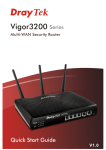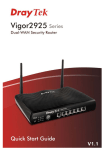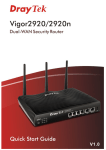Download Draytek Vigor3100V Installation guide
Transcript
Vigor 3100 Series Router Quick Start Guide Version: 2.0 Date: 2007/11/8 Please visit www.draytek.com to get the newly updated manual at any time. i Copyright Information Copyright Declarations Copyright 2007 All rights reserved. This publication contains information that is protected by copyright. No part may be reproduced, transmitted, transcribed, stored in a retrieval system, or translated into any language without written permission from the copyright holders. Trademarks The following trademarks are used in this document: z Microsoft is a registered trademark of Microsoft Corp. z Windows, Windows 95, 98, Me, NT, 2000, XP and Explorer are trademarks of Microsoft Corp. z Apple and Mac OS are registered trademarks of Apple Computer Inc. z Other products may be trademarks or registered trademarks of their respective manufacturers. Safety Instructions and Approval Safety Instructions Warranty z z Read the installation guide thoroughly before you set up the router. The router is a complicated electronic unit that may be repaired only be authorized and qualified personnel. Do not try to open or repair the router yourself. z Do not place the router in a damp or humid place, e.g. a bathroom. z The router should be used in a sheltered area, within a temperature range of +5 to +40 Celsius. z Do not expose the router to direct sunlight or other heat sources. The housing and electronic components may be damaged by direct sunlight or heat sources. z Do not deploy the cable for LAN connection outdoor to prevent electronic shock hazards. z Keep the package out of reach of children. z When you want to dispose of the router, please follow local regulations on conservation of the environment. We warrant to the original end user (purchaser) that the router will be free from any defects in workmanship or materials for a period of two (2) years from the date of purchase from the dealer. Please keep your purchase receipt in a safe place as it serves as proof of date of purchase. During the warranty period, and upon proof of purchase, should the product have indications of failure due to faulty workmanship and/or materials, we will, at our discretion, repair or replace the defective products or components, without charge for either parts or labor, to whatever extent we deem necessary tore-store the product to proper operating condition. Any replacement will consist of a new or re-manufactured functionally equivalent product of equal value, and will be offered solely at our discretion. This warranty will not apply if the product is modified, misused, tampered with, damaged by an act of God, or subjected to abnormal working conditions. The warranty does not cover the bundled or licensed software of other vendors. Defects which do not significantly affect the usability of the product will not be covered by the warranty. We reserve the right to revise the manual and online documentation and to make changes from time to time in the contents hereof without obligation to notify any person of such revision or changes. Be a Registered Owner Web registration is preferred. You can register your Vigor router via http://www.draytek.com. Firmware & Tools Updates Due to the continuous evolution of DrayTek Corporation, all routers will be regularly upgraded. Please consult the DrayTek web site for more information on newest firmware, tools and documents. http://www.draytek.com ii European Community Declarations Manufacturer: Address: Product: DrayTek Corp. No. 26, Fu Shing Road, HuKou County, HsinChu Industrial Park, Hsin-Chu, Taiwan 303 Vigor3100 Series G.SHDSL Routers DrayTek Corp. declares that Vigor3100 series of routers are in compliance with the following essential requirements and other relevant provisions of R&TTE Directive 1999/5/EEC. The product conforms to the requirements of Electro-Magnetic Compatibility (EMC) Directive 89/336/EEC by complying with the requirements set forth in EN55022/Class B and EN55024/Class B. The product conforms to the requirements of Low Voltage (LVD) Directive 73/23/EEC by complying with the requirements set forth in EN60950. The Vigor3100G is designed for the WLAN 2.4GHz network throughout EC region, Switzerland, and the restrictions of France. Regulatory Information Federal Communication Commission Interference Statement This equipment has been tested and found to comply with the limits for a Class B digital device, pursuant to Part 15 of the FCC Rules. These limits are designed to provide reasonable protection against harmful interference in a residential installation. This equipment generates, uses and can radiate radio frequency energy and, if not installed and used in accordance with the instructions, may cause harmful interference to radio communications. However, there is no guarantee that interference will not occur in a particular installation. If this equipment does cause harmful interference to radio or television reception, which can be determined by turning the equipment off and on, the use is encouraged to try to correct the interference by one of the following measures: z Reorient or relocate the receiving antenna. z Increase the separation between the equipment and receiver. z Connect the equipment into an outlet on a circuit different form that to which the receiver is connected. z Consult the dealer or an experienced radio/TV technician for help. This device complies with Part 15 of the FCC Rules. Operation is subject to the following two conditions: (1) This device may not cause harmful interference, and (2) This device may accept any interference received, including interference that may cause undesired operation. Please visit www.draytek.com/about_us/Regulatory.php. iii Table of Contents 1. Introduction........................................................................................................... 1 1.1 Panel Description ....................................................................................................................... 2 1.1.1 Vigor3100...................................................................................................................... 2 1.1.2 Vigor3100G ................................................................................................................... 3 1.1.3 Vigor3100i ..................................................................................................................... 4 1.1.4 Vigor3100V ................................................................................................................... 5 1.1.5 Vigor3120...................................................................................................................... 6 1.2 Package Content........................................................................................................................ 7 2. Install Your Vigor Router ...................................................................................... 9 2.1 Hardware Installation.................................................................................................................. 9 2.1.1 For Vigor3100/Vigor3100G/Vigor3100V/Vigor3100i..................................................... 9 2.1.2 Hardware Installation for Vigor3120............................................................................ 10 2.1.3 Pin Definition for Flat Module Cable ........................................................................... 11 2.2 Rack Mount Instruction .............................................................................................................11 2.3 Web Configuration.................................................................................................................... 12 2.4 Printer Installation..................................................................................................................... 14 2.5 Network Connection by 3G USB Modem................................................................................. 19 3. Wireless LAN Settings for Vigor3100G............................................................. 21 3.1 Basic Wireless LAN Concept ................................................................................................... 21 3.2 Boost Up Your Wireless Speed ................................................................................................ 21 3.3 General Settings....................................................................................................................... 22 4. Trouble Shooting ................................................................................................ 23 4.1 Checking If the Hardware Status Is OK or Not......................................................................... 23 4.2 Checking If the Network Connection Settings on Your Computer Is OK or Not ...................... 24 4.3 Pinging the Router from Your Computer .................................................................................. 26 4.4 Checking If the ISP Settings are OK or Not ............................................................................. 27 4.5 Backing to Factory Default Setting If Necessary...................................................................... 28 4.6 Contacting Your Dealer ............................................................................................................ 29 iv 1. Introduction Targeting requirement for residential, SOHO (Small Office and Home Office) and business users, the Vigor3100 series are G.SHDSL enabled integrated access device. G.SHDSL is going to be a prevailing standard for business and residential SDSL (Symmetrical DSL) in the rapidly growing worldwide marketplace. Vigor3100/G provides data upto 2.3Mbps through one single pair; Vigor3120 offers data upto 4.6Mbps through two pairs. Embedded with sophistic VPN firewall security features, the Vigor3100 series provide 32 dedicated virtual private data networks tunneling through public Internet. Powered by hardware-based DES/3DES engine, all the information transmitted is well encrypted. Hence Vigor3100 series can against any snooping without performance degraded when VPN is enabled. The Vigor3100 G model is embedded 802.11g compliant wireless module which provides wireless LAN access with line rate as much as 108Mbps with Super G TM. The Vigor3100 G models feature WPA2 (802.11i), wireless LAN isolation, and WDS (Wireless Distribution System). The Vigor3100i model supports one ISDN port. It provides Internet access, remote dial-in and ISDN backup features. Characteristics ¾ Easy Internet-sharing of your broadband connection ¾ Robust firewall to help protect your network from external attacks ¾ Comprehensive VPN facilities provide deployment of linked branch offices and teleworkers 1 1.1 Panel Description 1.1.1 Vigor3100 Front Panel LED Status Explanation ACT (Activity) Blinking The router is powered on and running properly. VPN On The VPN tunnel is launched. QoS On The QoS function is active. PRN On The USB interface printer is ready. DSL On The G.SHDSL line is connected LNK Blinking It means that Ethernet packets are transmitting. 100 On It means that a normal 100Mbps connection is through its corresponding port. Off It means that a normal 10Mbps connection is through its corresponding port. On It means a full duplex connection. Off It means a half duplex connection. Blinking It means that a packet collision happens. LAN (1, 2, 3, 4) FDX Interface Description RST (Factory Reset) Restore the default settings. Usage: Turn on the router (ACT LED is blinking). Press the hole and keep for more than 5 seconds. When you see the ACT LED begins to blink rapidly than usual, release the button. Then the router will restart with the factory default configuration. DSL Connect the G.SHDSL line to access the Internet. LAN (1,2,3,4) Connect to the local networked devices. PRN Connect to the USB printer. Rear Panel Interface Description Connecter for a power cord with 100-240 VAC (inlet). Power Switch. “1” is ON; “0” is OFF. 2 1.1.2 Vigor3100G Front Panel LED Status Explanation ACT (Activity) Blinking The router is powered on and running properly. VPN On The VPN tunnel is launched. QoS On The QoS function is active. PRN On The USB interface printer is ready. WLAN On The wireless LAN function is enabled. Blinking Wireless traffic goes through. On The G.SHDSL line is connected. Blinking It means that Ethernet packets are transmitting. On It means that a normal 100Mbps connection is through its corresponding port. Off It means that a normal 10Mbps connection is through its corresponding port. On It means a full duplex connection. Off It means a half duplex connection. Blinking It means that a packet collision happens. DSL LNK 100 LAN (1, 2, 3, 4) FDX Interface Description RST (Factory Reset) Restore the default settings. Usage: Turn on the router (ACT LED is blinking). Press the hole and keep for more than 5 seconds. When you see the ACT LED begins to blink rapidly than usual, release the button. Then the router will restart with the factory default configuration. DSL Connect the G.SHDSL line to access the Internet. LAN (1,2,3,4) Connect to the local networked devices. PRN Connect to the USB printer. Rear Panel Interface Description Connecter for a power cord with 100-240 VAC (inlet). Power Switch. “1” is ON; “0” is OFF. 3 1.1.3 Vigor3100i Front Panel LED Status Explanation ACT (Activity) Blinking The router is powered on and running properly. VPN On The VPN tunnel is launched. QoS On The QoS function is active. PRN On On Blinking On The USB interface printer is ready. The ISDN service function is active. It means that data is transmitting. The G.SHDSL line is connected LNK Blinking It means that Ethernet packets are transmitting. 100 On It means that a normal 100Mbps connection is through its corresponding port. Off It means that a normal 10Mbps connection is through its corresponding port. On It means a full duplex connection. Off It means a half duplex connection. Blinking It means that a packet collision happens. ISDN DSL LAN (1, 2, 3, 4) FDX Interface Description RST (Factory Reset) Restore the default settings. Usage: Turn on the router (ACT LED is blinking). Press the hole and keep for more than 5 seconds. When you see the ACT LED begins to blink rapidly than usual, release the button. Then the router will restart with the factory default configuration. ISDN Connect the ISDN cable. DSL Connect the G.SHDSL line to access the Internet. LAN (1,2,3,4) Connect to the local networked devices. PRN Connect to the USB printer. Rear Panel Interface Description Connecter for a power cord with 100-240 VAC (inlet). Power Switch. “1” is ON; “0” is OFF. 4 1.1.4 Vigor3100V Front Panel LED Status Explanation ACT (Activity) Blinking The router is powered on and running properly. VPN On The VPN tunnel is launched. QoS On The QoS function is active. PRN On The USB interface printer is ready. VoIP (2,1) On The phone is off hook (the handset of phone is hanging). Blinking A phone call is incoming or on-line. On The G.SHDSL line is connected LNK Blinking It means that Ethernet packets are transmitting. 100 On It means that a normal 100Mbps connection is through its corresponding port. Off It means that a normal 10Mbps connection is through its corresponding port. On It means a full duplex connection. Off It means a half duplex connection. Blinking It means that a packet collision happens. DSL LAN (1, 2, 3, 4) FDX Interface Description RST (Factory Reset) Restore the default settings. Usage: Turn on the router (ACT LED is blinking). Press the hole and keep for more than 5 seconds. When you see the ACT LED begins to blink rapidly than usual, release the button. Then the router will restart with the factory default configuration. VoIP Connecters for telephone set and analog phone with VoIP communication. DSL Connect the G.SHDSL line to access the Internet. LAN (1,2,3,4) Connect to the local networked devices. PRN Connect to the USB printer. Rear Panel Interface Description Connecter for a power cord with 100-240 VAC (inlet). Power Switch. “1” is ON; “0” is OFF. 5 1.1.5 Vigor3120 Front Panel LED Status Explanation ACT (Activity) Blinking The router is powered on and running properly. VPN On The VPN tunnel is launched. QoS On The QoS function is active. PRN On The USB interface printer is ready. DSL On The G.SHDSL line is connected. Blinking It means that Ethernet packets are transmitting. On It means that a normal 100Mbps connection is through its corresponding port. Off It means that a normal 10Mbps connection is through its corresponding port. On It means a full duplex connection. Off It means a half duplex connection. Blinking It means that a packet collision happens. LNK 100 LAN (1, 2, 3, 4) FDX Interface Description RST (Factory Reset) Restore the default settings. Usage: Turn on the router (ACT LED is blinking). Press the hole and keep for more than 5 seconds. When you see the ACT LED begins to blink rapidly than usual, release the button. Then the router will restart with the factory default configuration. DSL(1/2) Connecter for remote networked devices. LAN (1-4) Connecter for local networked devices. PRN USB interface for printer. Rear Panel Interface Description Connecter for a power cord with 100-240 VAC (inlet). Power Switch. “1” is ON; “0” is OFF. 6 1.2 Package Content nQuick Start Guide oCD pRack mount kit (brackets) qAntenna for Vigor3100G rRJ-45 Cable (Ethernet) s Flat Module Cable, RJ-45 (8P8C) t Surface Jack (for Vigor3120) (4x4) (for Vigor3120) _RJ-45 to RJ-45 Cable for i model (8P4C) ` The type of the cable depends on the country that the router will be installed: Or RJ-11 to RJ-45 Cable (Annex B) (for Vigor3100/3100G) RJ-45 to RJ-45 (for Vigor3100/3100G) a The type of the power cord depends on the country that the router will be installed: UK-type power cord EU-type power cord USA/Taiwan-type power cord AU/NZ-type power cord 7 This page is left blank. 8 2. Install Your Vigor Router This section will guide you to install the router through hardware connection and configure the router’s settings through web browser. 2.1 Hardware Installation 2.1.1 For Vigor3100/Vigor3100G/Vigor3100V/Vigor3100i Before starting to configure the router, you have to connect your devices correctly. 1. Connect the DSL port of the router to the wall outlet with a RJ-11 to RJ-45 (or RJ-45 to RJ-45) cable. For Vigor3120, please refer to 2.2.1 2. Connect one port of 4-port switch to your computer with a RJ-45 cable. 3. Connect the printer/3G USB Modem to the router with the USB cable and connect the power cord. If you do not have a printer/3G USB Modem for using, skip this step. 4. Connect detachable antennas to the router for Vigor3100G. 5. Connect ISDN cable for Vigor3100i. 6. Connect one end of the power cord to the power port of the router. Connect the other end to the wall outlet of electricity. 7. Power on the router. 8. Check the ACT and DSL, LAN LEDs to assure network connections. (For the detailed information of LED status, please refer to section 1.1.) 9 2.1.2 Hardware Installation for Vigor3120 Vigor3120 provides Flat Module Cable (RJ-45, 4x4) for bonding bandwidth for data transmission. Please apply two-pair of circuit from your ISP first for hardware connection. Then, open the cover of surface jack and use a screw driver to loosen the screws inside the surface jack. Notice that lines wrapped with same color tape mean one pair. Please connect them to one surface jack (that will be used to connect to DSL connector of the router). Use the same way to connect another pair of lines to another surface jack (that will be used to connect to ISP). And before starting to configure the router, you have to connect your devices correctly. 1. Connect the DSL port of the router to the wall outlet with a Flat Module Cable (RJ-45, 4x4). 2. Connect one port of 4-port switch to your computer with a RJ-45 cable. 3. Connect the printer/3G USB Modem to the router with the USB cable and connect the power cord. If you do not have a printer/3G USB Modem for using, skip this step. 4. Connect one end of the power cord to the power port of the router. Connect the other end to the wall outlet of electricity. 5. Power on the router. 6. Check the ACT and DSL, LAN LEDs to assure network connections. (For the detailed information of LED status, please refer to section 1.1.) 10 2.1.3 Pin Definition for Flat Module Cable Below shows the pin definition of flat module cable. One pair is composed by Pin4 and Pin5. The other pair is composed by Pin3 and Pin6. 2.2 Rack Mount Instruction Use brackets to set the Vigor router on the rack as shown below. 11 2.3 Web Configuration The Quick Start Wizard is designed for you to easily set up your router for Internet access. You can directly access the Quick Start Wizard via Web Configurator. 1. Make sure your PC connects to the router correctly. Notice: You may either simply set up your computer to get IP dynamically from the router or set up the IP address of the computer to be the same subnet as the default IP address of Vigor router 192.168.1.1. For the detailed information, please refer to the later section - Trouble Shooting of the guide. 2. Open a web browser on your PC and type http://192.168.1.1. A pop-up window will open to ask for username and password. Do not type any word on the window and click OK for next screen. 3. Now, the Main Screen will pop up. Click Quick Start Wizard. Note: The home page will change slightly in accordance with the router you have. 12 4. Enter the login password on the field of New Password and retype it on the field of Confirm Password. Then click Next to continue. 5. On the next page as shown below, please select the appropriate Internet access type according to the information from your ISP. Or clicking “Auto detect” button to find out the related DSL parameters automatically. 6. If you select PPPoE/PPPoA as the protocol, please manually enter the Username/Password provided by your ISP. Check the Always On means Internet access is always on regardless of Internet usage. Then click Next. 13 7. Review the summary of settings. If everything is OK, click Finish to exit the wizard. 2.4 Printer Installation You can install a printer onto the router for sharing printing. All the PCs connected this router can print documents via the router. The example provided here is made based on Windows XP/2000. For Windows 98/SE, please visit www.draytek.com. Before using it, please follow the steps below to configure settings for connected computers (or wireless clients). 1. Connect the printer with the router through USB/parallel port. 2. Open Start->Settings-> Printer and Faxes. 14 3. Open File->Add a New Computer. A welcome dialog will appear. Please click Next. 4. Click Local printer attached to this computer and click Next. 5. In this dialog, choose Create a new port Type of port and use the drop down list to select Standard TCP/IP Port. Click Next. 6. In the following dialog, type 192.168.1.1 (router’s LAN IP) in the field of Printer Name or IP Address and type IP_192.168.1.1 as the port name. Then, click Next. 15 7. Click Standard and choose Generic Network Card. 8. Then, in the following dialog, click Finish. 16 9. Now, your system will ask you to choose right name of the printer that you installed onto the router. Such step can make correct driver loaded onto your PC. When you finish the selection, click Next. 10. For the final stage, you need to go back to Control Panel-> Printers and edit the property of the new printer you have added. 17 11. Select "LPR" on Protocol, type p1 (number 1) as Queue Name. Then click OK. Next please refer to the red rectangle for choosing the correct protocol and UPR name. The printer can be used for printing now. Most of the printers with different manufacturers are compatible with vigor router. Note 1: Some printers with the fax/scanning or other additional functions are not supported. If you do not know whether your printer is supported or not, please visit www.draytek.com to find out the printer list. Open Support Center->FAQ->Sort by product; select the model of the router and click on it; find out the link of Printer Server FAQ; click the What types of printers are compatible with Vigor router? link. Note 2: Vigor router supports printing request from computers via LAN ports but not WAN port. 18 2.5 Network Connection by 3G USB Modem For 3G mobile communication through Access Point is getting more and more popular, Vigor3100 adds the function of 3G backup for such purpose. By connecting 3G USB Modem to the USB port of Vigor3100, it can support HSDPA/UMTS/EDGE/GPRS/GSM and the future 3G standard (HSUPA, etc). Vigor3100 with 3G USB Modem allows you to receive 3G signals at any place such as your car or certain location holding outdoor activity and share the bandwidth for using by more people. Users can use four LAN ports on the router to access Internet. Also, they can access Internet via SuperG wireless function of Vigor3100, and enjoy the powerful firewall, bandwidth management, VPN, VoIP features of Vigor3100 series. After connecting into the router, 3G USB Modem will be regarded as Internet backup device. Therefore, when WAN1 is not available, the router will use 3G for supporting automatically. The supported 3G USB Modem will be listed on Draytek web site. Please visit www.draytek.com for more detailed information. 19 20 3. Wireless LAN Settings for Vigor3100G For operating Vigor3100G well, it is necessary for you to set the wireless LAN settings for using wireless function. Please read the following section carefully for configuring the settings for this router. (The default value of Frequency Domain was set by factory depends on the reselling region.) 3.1 Basic Wireless LAN Concept In an Infrastructure Mode of wireless network, Vigor wireless router plays a role as an Access Point (AP) connecting to lots of wireless clients or Stations (STA). All the STAs will share the same Internet connection with other wired hosts via Vigor wireless router. 3.2 Boost Up Your Wireless Speed The Vigor wireless routers are equipped with a wireless LAN interface compliant with the standard IEEE 802.11g protocol. To boost its performance further, the Vigor Router is also loaded with advanced wireless technology Super G TM to lift up data rate up to 108 Mbps*. Hence, you can finally smoothly enjoy stream music and video. * The actual data throughput will vary according to the network conditions and environmental factors, including volume of network traffic, network overhead and building materials. Only Super G STAs can achieve performance boost together with Vigor Super GTM router. 21 3.3 General Settings Click Wireless LAN >>General Settings to configure the Service Set Identifier (SSID) and wireless channel. 1. Check the box Enable Wireless LAN to enable wireless function. 2. Select an appropriate wireless mode. 3. Mixed (11b+11g+Super G) The router can connect to IEEE802.11b, IEEE802.11g and Super G stations simultaneously. If you don’t know which one is suitable for your router, please choose this mode. Mixed (11b+11g) Super G only The router can connect to IEEE802.11b and IEEE802.11g stations simultaneously. The router can connect to Super G stations. 11g-only The router can connect to IEE802.11g stations. 11b-only The router can connect to IEE802.11b stations. Type in the name of the SSID and Channel. The default name for SSID is "default". We suggest you change it to a particular name. SSID (service set identifier) It is used to name the wireless LAN for this router, and it must have the same content in client PC/notebook wireless card(s). SSID can be any text numbers or various special characters. Channel It is a wireless channel for the router. The default channel is 6. You can change it to an appropriate one if the selected channel is under serious interference. 22 4. Trouble Shooting This section will guide you to solve abnormal situations if you cannot access into the Internet after installing the router and finishing the web configuration. Please follow sections below to check your basic installation stage by stage. ¾ Checking if the hardware status is OK or not. ¾ Checking if the network connection settings on your computer are OK or not. ¾ Pinging the router from your computer. ¾ Checking if the ISP settings are OK or not. ¾ Backing to factory default setting if necessary. If all above stages are done and the router still cannot run normally, it is the time for you to contact your dealer for advanced help. 4.1 Checking If the Hardware Status Is OK or Not Follow the steps below to verify the hardware status. 1. Check the power line and WLAN/LAN cable connections. Refer to “2.1 Hardware Installation” for details. 2. Turn on the router. Make sure the ACT LED blink once per second and the correspondent LAN LED is bright. 3. If not, it means that there is something wrong with the hardware status. Simply back to “2.1 Hardware Installation” to execute the hardware installation again. And then, try again. 23 4.2 Checking If the Network Connection Settings on Your Computer Is OK or Not Sometimes the link failure occurs due to the wrong network connection settings. After trying the above section, if the link is stilled failed, please do the steps listed below to make sure the network connection settings is OK. For Windows The example is based on Windows XP. As to the examples for other operation systems, please refer to the similar steps or find support notes in www.draytek.com. 1. Go to Control Panel and then double-click on Network Connections. 2. Right-click on Local Area Connection and click on Properties. 3. Select Internet Protocol (TCP/IP) and then click Properties. 24 4. Select Obtain an IP address automatically and Obtain DNS server address automatically. For MacOs 1. Double click on the current used MacOs on the desktop. 2. Open the Application folder and get into Network. 3. On the Network screen, select Using DHCP from the drop down list of Configure IPv4. 25 4.3 Pinging the Router from Your Computer The default gateway IP address of the router is 192.168.1.1. For some reason, you might need to use “ping” command to check the link status of the router. The most important thing is that the computer will receive a reply from 192.168.1.1. If not, please check the IP address of your computer. We suggest you setting the network connection as get IP automatically. (Please refer to the section 4.2) Please follow the steps below to ping the router correctly. For Windows 1. 2. Open the Command Prompt window (from Start menu> Run). Type command (for Windows 95/98/ME) or cmd (for Windows NT/ 2000/XP). The DOS command dialog will appear. 3. Type ping 192.168.1.1 and press [Enter]. It the link is OK, the line of “Reply from 192.168.1.1:bytes=32 time<1ms TTL=255” will appear. 4. If the line does not appear, please check the IP address setting of your computer. For MacOs (Terminal) 1. Double click on the current used MacOs on the desktop. 2. Open the Application folder and get into Utilities. 3. Double click Terminal. The Terminal window will appear. 4. Type ping 192.168.1.1 and press [Enter]. It the link is OK, the line of “64 bytes from 192.168.1.1: icmp_seq=0 ttl=255 time=xxxx ms” will appear. 26 4.4 Checking If the ISP Settings are OK or Not Click Internet Access Setup group and then check whether the ISP settings are set correctly. For PPPoE/PPPoA Users 1. Check if the Enable option is selected. 2. Check if all parameters of DSL Modem Settings are entered with correct values that you got from your ISP. 3. Check if Username and Password are entered with correct values that you got from your ISP. 27 For MPoA (RFC1483/2684) Users 1. Check if the Enable option is selected. 2. Check if all parameters of DSL Modem Settings are entered with correct values that you got from your ISP. 3. Check if IP Address, Subnet Mask and Gateway are set correctly, or use DHCP server to obtain IP automatically by clicking Obtain an IP address automatically. 4.5 Backing to Factory Default Setting If Necessary Sometimes, a wrong connection can be improved by returning to the default settings. Try to reset the router by software or hardware. Warning: After pressing factory default setting, you will loose all settings you did before. Make sure you have recorded all useful settings before you pressing. The password of factory default is null. Software Reset You can reset router to factory default via Web page. Go to System Maintenance >> Reboot System on the web page. The following screen will appear. Choose Using factory default configuration and click OK. After few seconds, the router will return all the settings to the factory settings. 28 Hardware Reset While the router is running (ACT LED blinking), press the RST button and hold for more than 5 seconds. When you see the ACT LED blinks rapidly, please release the button. Then, the router will restart with the default configuration. After restore the factory default setting, you can configure the settings for the router again to fit your personal request. 4.6 Contacting Your Dealer If the router still cannot work correctly after trying many efforts, please contact your dealer for further help right away. For any questions, please feel free to send e-mail to [email protected]. 29












































